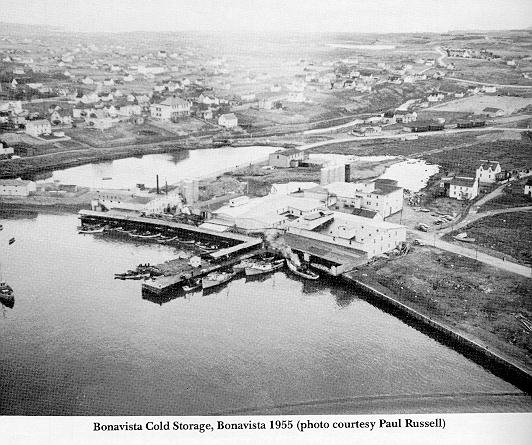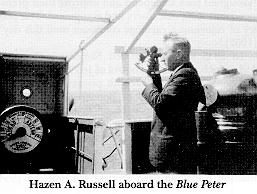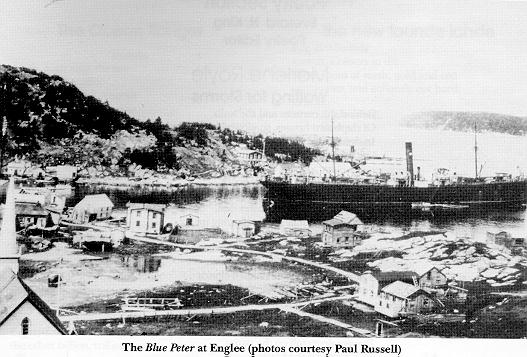


by
Melvin Baker (c)1995
Originally Published in the Newfoundland Quarterly, Vol. LXXXIX, No. 3, (Spring/Summer 1995)
Hazen Russell was born on 8 March 1892, at Grand Manan, New Brunswick, the son of Alfaretta (Welch) and Peter Power Russell. After receiving his early education at Grand Manan and St. Andrews, New Brunswick, in 1910 Russell joined the St. Andrews' branch of the Bank of Nova Scotia. It was his banking career that brought him to Newfoundland in 1916, to open a branch of the Bank of Nova Scotia at Catalina. At that time William Coaker, president of the Fishermen's Protective Union, was establishing a new town on Catalina harbour (later known as Port Union). Port Union became the headquarters of the Fishermen's Union Trading Company, exporting sailfish to the Mediterranean, the West Indies, and Brazil.
The Trading Company was one of the bank's largest clients. Russell's business acumen soon greatly impressed Coaker, who offered him the position of manager of the Union's commercial activities. Satisfied with his work at the bank, Russell asked Coaker for a figure much higher than his present salary, hoping that Coaker would withdraw the offer. Undaunted, Coaker agreed to the young banker's terms, and in 1918 Russell became manager of the Union's companies. Also in 1918, Russell married Ora Isabine Johnson, who was on summer vacation in Catalina visiting her uncle, Catalina's resident community doctor, Alexander McKay.(1) They were to have three daughters and two sons.
Having made a career change, Russell set out to learn the fish business. For several years he would go to work in the fish store for one to two hours daily, then go to his office for the rest of the day. He had innovative ideas for managing the business and by 1925 had a small cold storage plant installed for freezing of bait and salmon, the latter for export to Canada.(2)
In 1928 Russell resigned from the Trading Company with plans to return to Canada. However, Robert Job of Job Brothers Ltd. offered him a position with his St. John's company. Russell accepted, becoming a director of the company in 1927 and its president in 1946.(3) Job Brothers had already purchased the 5000-ton refrigerator ship S.S. Blue Peter, to use as a floating cold store. This was found to be impractical, so Russell had the ship outfitted with a brine freezing system and a canning plant and used her to pack salmon on the northeast coast of Newfoundland to Labrador. This venture was successful for a decade with the total production being delivered to England until 1937. It would appear that the Blue Peter was the first such factory ship in the world. On return from England the Blue Peter would dock at Conception Harbour and freeze blueberries for export.
In 1932 Russell converted a steam trawler, the Lutzen, to diesel propulsion and also refitted her as a refrigerator carrier. Later her sister vessel, the Seneff, was similarly modified and in 1940 the Silver City was also converted to diesel and refrigeration. In May of 1946 Russell formed Blue Peter Steamships Ltd. to operate as a general freighting operation, but also to carry frozen cargoes to Canada and the United States.
In 1939 Russell formed the Bonavista Cold Storage Company at Bonavista, taking over the premises of the insolvent firm of W.H. House & Co. Ltd., which had been acquired by Job Brothers. The Bonavista company gradually built up a fish processing and freezing operation, capable of handling large quantities of fish daily and also freezing squid and blueberries. The original shareholders of the Bonavista company had previously been shareholders in Northeastern Steamships Ltd., the owners of the Lutzen, which had become a total lost in 1938.(4) The new company gave local fishermen a choice in disposing of their catches and many opted to sell their fish fresh to the plant for cash. During the war, Russell later wrote, "substantial quantities of frozen fish were produced for the British Ministry of Foods and on this fair profits were made." These profits as well as smaller profits earned after the War were "ploughed back to expand and improve their premises, processing machinery and equipment. This policy of reinvesting earnings continues until this day" [1962].(5)
In 1945 Russell organized Northlantic Fisheries Ltd., which purchased control of Job Brothers & Co. Ltd. and, in conjunction with private shareholders, gained effective control of Bonavista Cold Storage Co. Ltd. (and later Blue Peter Steamships, Northlantic Trawlers Ltd., St. Anthony Cold Storage Co., and Canada Bay Cold Storage Co. Ltd.) Russell was president and general manager of these companies from 1945 until 1953, when he resigned to manage Bonavista Cold Storage full time. In 1954 the Bonavista company took over construction of a partially-completed fish processing plant at Grand Bank. This new plant commenced operations in June 1955 with two steel trawlers. Russell continued in pioneering technological development, with Bonavista Cold Storage being the first Canadian company to build a stern ramp steel trawler for the Canadian ground fishery in 1962. In 1974 Bonavista Cold Storage sold its interests to the Lake Group of Companies, owned by Spencer Lake of Burgeo. Russell had been a prominent figure in the Newfoundland fishery since his initial involvement with Coaker and served on numerous government bodies, such as the Newfoundland Industrial Board during the 1940s, and (after 1949) as a director the Bank of Canada, the Federal Industrial Development Board (1950-1961), as president of the Fisheries Council of Canada (1954-1955), and as a director of the Fisheries Research Board of Canada (1964- 1967).(6)
Hazen Russell strongly believed that the success of the fish business had to be built on producing quality products. As he commented in 1932, "no amount of freezing or other treatment in the cold storage plants can make a second quality fish into a first."(7) In the 1960s Russell was pessimistic about the extent of the fishing effort by foreign countries in the northwest Atlantic and felt it could not continue without permanent damage to fish stocks.
Russell's career in the fish trade is interwoven with the history of the local fisheries for much of the 20th century and is worthy of further study. He died at St. John's on November 14, 1983. (The author would like to acknowledge the assistance of the late Charles R. Granger in the preparation of this article.)
Notes


